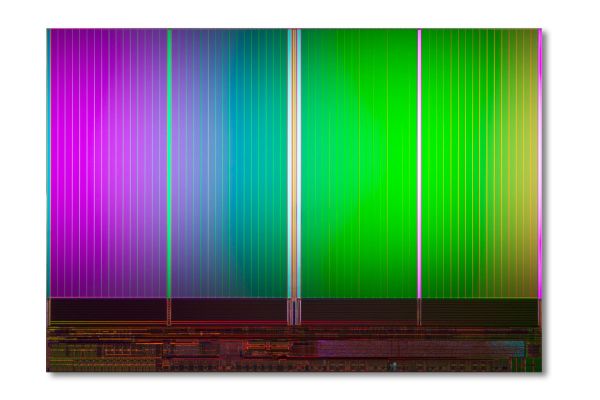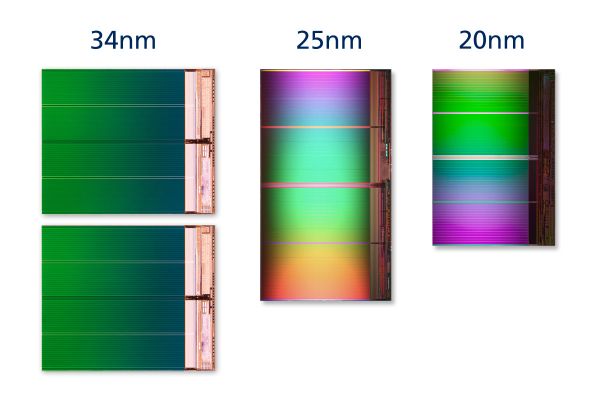Intel & Micron Announce First 20nm MLC NAND Flash for Use in SSDs
by Anand Lal Shimpi on April 14, 2011 11:49 AM EST
We just started testing SSDs based on IMFT 25nm NAND Flash and look at what Intel/Micron just announced? The first 8GB MLC NAND device built on a 20nm process. This is obviously an announcement of pre-production silicon, it’ll take IMFT until the second half of this year (at least) to start shipping production quality 20nm NAND.

IMFT 20nm 8GB NAND, 118mm2
At 50nm IMFT NAND was good for 10,000 program/erase cycles (rated, not actual). The move to 34nm dropped that to 3000 - 5000 program erase cycles, a value that was maintained with the move to 25nm. I asked Micron how long NAND will last at 20nm and was told that p/e cycles are comparable to where 25nm was at a similar point in its development cycle. Micron expects quality to ramp over time and ultimately hit a similar point to existing 25nm NAND, which is good for controller manufacturers as it means any ECC/NAND redundancy efforts they have already implemented should support the new 20nm product.
An 8GB 2-bit-per-cell MLC NAND device built at 20nm has a die area of 118mm2, down from 167mm2 at 25nm. A single 8GB NAND device wasn’t built at 34nm.
IMFT is on a 15 - 18 month process cadence, meaning this transition was of course planned for in advance. The first 20nm NAND is being manufactured at the IMFT Fab in Lehi, Utah, which is currently producing 25nm NAND. Some equipment upgrades are necessary to support 20nm. IMFT will also transition its fabs in Manassas, VA and Singapore to 20nm at a later point.
For consumers there’s an obvious win. We need smaller transistor geometries to reduce the cost of NAND, which ultimately reduces the cost of SSDs. The days of 50% annual price reductions are over however, expect to see a conservative 20 - 30% drop in price for SSDs that use 20nm NAND over 25nm NAND.











38 Comments
View All Comments
PubFiction - Friday, April 15, 2011 - link
The future of SSDs as a mainstream storage medium is all about their ability to scale down reliably.If they cannot scale down reliably then we will not get cheaper drives. Just like we have seen in this last generation there was no 1/2 price break. So the price / GB is not dropping very fast. On top of that we have the issue where smaller nodes may be unable to achieve as many writes. If that keeps going by the time we drop to 10 nm we may realistically be at a situation where SSDs become disposable items and if that is the case the cost will seem high for what you are getting. I buy all my PC components with the expectation they will last me about 2 year THEN I will pass them on to other family members who will use them for much longer. Also if you talk to the average person out on the street they usually think that they should be able to use their computer much longer than 3 years.
So for reliable SSDs that last a while will be continue to squeeze 3000 writes out of them or will they continue to move down with each die shrink? And will this loss of reliability get to a point where we have to choose between cheaper drives which wear out and more reliable drives that are expensive and built on older nodes.
Movieman420 - Friday, April 15, 2011 - link
One of the biiig selling points for SF is their great ability to handle the ever increasing ECC demands that go hand in hard with each die shrink. And if one couples that with the upcoming 'self-ECC' equipped nand...SF will continue to look good. Then throw toggle nand and onfi 2.0 nand around the corner in the mix...2011 WILL be the year that SSD technology truly establishes it's self beyond ANY doubts. And this info is based on what I know of the SF1200/1500...imagine what the 22xx and 25xx have in store. Insert drool here.ClagMaster - Friday, April 15, 2011 - link
I suppose this is progress of sorts. Still, for a 2000-3000 cyling life, this is OK.What is the next stepdown in NAND gates ?
When I can get a 120 GB SSD with SATA 6G for $120 or less, then I will make the swich for my desktop.
sweinhart2006 - Saturday, April 16, 2011 - link
I find it quite amusing to see people pick and choose bits of information and mix them up out of context to make up their own opinions so far from the truth it makes me laugh. Anand has explained in multiple articles why the pe cycle issue is really a non-issue. For most users an SSD will last well over 5 years. And if your using an SSD to record music and movies, you are just waisting your money because media throughput does not require 3-6Gbps and wont make a bit of difference during playback. And unlike processors, there isnt nearly as much profit margin on NAND devices. It takes 5-10x as much silicon real estate while selling for the same price as a midrange cpu. The more real estate required to manufacture a single device, the more yield issues and defects come into play when factoring in costs of manufacturing.epeets - Sunday, April 17, 2011 - link
Good cause the obvious rewards from this advancement can be seen but bad cause big business will cause them to charge us more for it before they actually drop the price on anything.endervalentine - Monday, April 18, 2011 - link
Not sure if Anand or anyone else can chime in on how they're able to overcome program disturbs at 20nm. Also, what engineering ingenuity are they doing to get down to 15nm, with SSD it seems like disturbs are a bigger limiting factor compared to the litho.zvadim - Tuesday, April 19, 2011 - link
the MLC NAND wearing issue will become a none-issue with eventual scale up of storage capacity & decline in price. With proper wear-leveling, 3000 writes on a 300GB drive is much less of an issue then on a 40GB one. Drive capacities at same price points are bound to start doubling sooner or later, and the NAND wear will be forgotten by all but the controller designers & manufacturing engineers.kjdjasgj - Thursday, May 12, 2011 - link
www.stylishdudes.com
All kinds of shoes + tide bag
Free transport